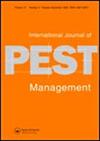化学杀菌剂和生物杀菌剂对苹果和梨内生真菌病害的体内外活性研究
IF 1.1
4区 农林科学
Q3 ENTOMOLOGY
引用次数: 0
摘要
摘要由球孢菌引起的枯死病和溃疡病影响了柚子果园的生产。在本研究中,我们通过体外和田间试验评估了杀菌剂和生物絮凝剂对苹果和梨溃疡病和枯死病的防治效果。利用苹果中的Diplodia seriata、D.mutila和Dothiorella omnivora,以及梨中的D.seriata和Aplosporella aquifolii的分离株。Cercobin®(甲基托布津),其次是Bellis®(吡唑菌胺 + boscalid)和Nativo®(戊唑醇 + 三氟司琼)在体外抑制所有真菌分离株的菌丝生长、分生孢子萌发和pycnidia形成。在双培养试验中,哈茨霉产生菌丝生长抑制和真菌寄生作用。甲基托布津和哈齐亚木霉完全抑制pycnidia的产生,而吡唑菌胺 + 博斯卡立德和戊唑醇 + 三氟司琼对分生孢子萌发最为有效。在果园试验中,在修剪伤口上喷洒杀菌剂可将发病率降低20%,而哈茨霉和戊唑醇则可降低发病率 + 三氟司琼使病变的严重程度分别降低了37%和41%。这项研究首次评估了杀菌剂和生物絮凝剂在阿根廷控制苹果和梨溃疡病和枯死病方面的有效性。本文章由计算机程序翻译,如有差异,请以英文原文为准。
In vitro and in vivo activity of chemical fungicides and a biofungicide for the control of wood diseases caused by botryosphaeriales fungi in apple and pear
Abstract Dieback and canker disease caused by species of Botryosphaeriales affect the productivity of pome fruit orchards. In this study, we evaluated the efficacy of fungicides and biofungicide for controlling canker and dieback diseases in apple and pear using in vitro and field trials. Isolates of Diplodia seriata, D. mutila, and Dothiorella omnivora from apple, and of D. seriata and Aplosporella aquifolii from pear were used. Cercobin® (thiophanate-methyl), followed by Bellis® (pyraclostrobin + boscalid), and Nativo® (tebuconazole + trifloxystrobin) inhibited mycelial growth, conidial germination and pycnidia formation in vitro in all fungal isolates. T. harzianum produced mycelial growth inhibition and mycoparasitism in dual culture assays. Thiophanate-methyl and T. harzianum fully inhibited pycnidia production, while pyraclostrobin + boscalid and tebuconazole + trifloxystrobin were most effective against conidia germination. In the orchard assays, protective sprays of the fungicides on pruning wounds reduced incidence by up to 20%, while T. harzianum and tebuconazole + trifloxystrobin reduced the lesion severity up 37 and 41%, respectively. This study represents the first evaluation of fungicides and biofungicide effectiveness for the control of canker and dieback diseases of apples and pears in Argentina.
求助全文
通过发布文献求助,成功后即可免费获取论文全文。
去求助
来源期刊
CiteScore
4.70
自引率
6.70%
发文量
74
审稿时长
>12 weeks
期刊介绍:
International Journal of Pest Management publishes original research papers and reviews concerned with pest management in the broad sense, covering the control of pests (invertebrates, vertebrates and weeds) and diseases of plants, fungi and their products – including biological control, varietal and cultural control, chemical controland interference methods.
The management of invasive species is of special interest. We also encourage submissions dealing with interactions of multiple pests such as arthropods and plant pathogens, pathogens and weeds or weeds and arthropods as well as those dealing with the indirect and direct effects of climate change on sustainable agricultural practices.

 求助内容:
求助内容: 应助结果提醒方式:
应助结果提醒方式:


